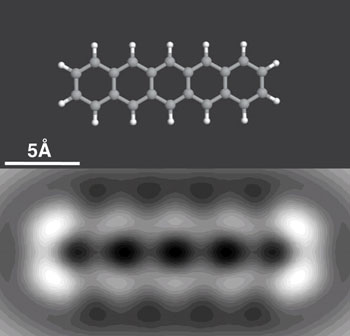Molecules in close-up
27 August 2009
A tuning-fork-like device that measures atomic forces is able to image every single atom in a molecule, according to its Swiss inventors. They have been able to get a sharper 'photograph' of a molecule's structure than ever before, and the ability to view molecular structures at this level expected to have potential implications in the emerging field of molecular electronics.
Leo Gross and colleagues at IBM Research in Zurich were able to image all the atoms in the pentacene - consisting of five benzene rings fused in a line - by tweaking a known vibrating cantilever technique called non-contact atomic force microscopy (NC-AFM).1 'This is the first time that all the atoms in a molecule have been imaged,' exclaims Gross.
The NC-AFM tip is attached to a very small tuning fork, which oscillates at amplitudes of 0.2 to 0.5 angstrom - much smaller than an atom's diameter. 'If you come very close to a surface, this frequency slightly changes and you get a 'detuning' because of the influence of the forces between the tip and the surface,' explains Gross.
'Above the skeleton of the molecular backbone [of the pentacene] you get a different detuning than above the surface the molecule is lying on,' he adds. And it is that detuning that is measured, and converted into an image.

Ball and stick model of pentacene (above) and NC-AFM image of pentacene on a copper surface (below) © Science/IBM Research - Zurich |
It is the molecule at the tip of the AFM that dictates the clarity of the image taken, but previous studies had struggled to clarify which molecules were at the tip when clear images were produced. It was the ability to control what atom or molecule was on the tip of the AFM that was key to Gross's project, he says.
The team was able to attach a carbon monoxide molecule to the end of their AFM tip and keep it there throughout the imaging process. 'With this CO molecule at the tip we get a very high resolution,' says Gross.
In NC-AFM, as the name suggests, there is no physical contact between the tip and the molecule it is imaging. Previously, there have been problems with the tips accidently sticking to the molecules, and dragging them around the surface during the imaging process. 'The CO doesn't bond to the pentacene molecule,' Gross says, and this means the tip can get very close to the molecule and therefore provide a better image.
The team's technique works with the pentacene laid on both conducting (copper) and non-conducting (sodium chloride) surfaces. The images on the copper surface are slightly clearer because the molecule sticks better to it, allowing the tip to get closer before the molecule starts to be dragged around. But the images on the non-conducting surface are the most relevant, Gross explains.
'The images on the insulating surface are important because eventually we want to investigate using molecules for molecular electronics,' says Gross. 'We want to use molecules as wires or logic switches or elements.' And to study molecules for this purpose their electrons must not have any interaction with the surface they are held on.
Franz Giessibl, an expert in AFM at the University of Regensburg in Germany, says the work is fantastic. 'What is special about it is the very small oscillation amplitude that they are using, which allows them to focus on very short range interactions.'
'As far as I know, molecules have not been seen with such resolution. It really looks like a textbook example of a drawn molecule,' he adds.
Earlier this year, Gross's team released results showing that using the same NC-AFM machine they could image the amount of charge on single atoms.2 'Now we would like to combine these two works, to observe the transport of charge through molecules on the single electron scale.'
'We plan to attach an electron to an atom, that is attached to a molecule, and then image how this charge is distributed over the actual molecule complex,' he says.
Nina Notman
References
- Leo Gross et al, Science, 2009, DOI: 10.1126/science.1176210
- Leo Gross et al, Science, 2009, 324, 1428 (DOI: 10.1126/science.1172273)
